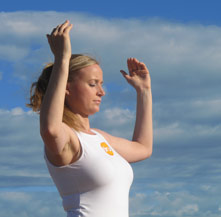
Dru Yoga has its roots in hatha yoga, and includes classical yoga postures (asanas), pranayama (the science of breath), mudras (hand gestures), positive affirmations, empowering visualisations, and powerful sequences, performed in a flowing and dynamic style. Dru Yoga classes are tailored to the level of the individuals within the class and usually contain Energy Block Release Sequences (EBRs), postures, flowing yoga sequences, pranayama, relaxation and Dru Meditation.
What is unique about Dru Yoga?
- Joints are kept relaxed and soft during movement (as in tai chi). This creates flexibility and a free flow of subtle energy. It protects your joints and increases strength and stamina.
- Dru Yoga teachers are trained to make their classes suitable for all levels of fitness from ‘full sweat’ to ‘no sweat’!
- Dru Yoga's Energy Block Release (EBR) sequences; easy-to-practise, flowing movements that help to release tension physically, mentally and emotionally.
- In Dru Yoga all movements originate from the spine, because a flexible, healthy spine supports your entire yoga practice.
- The spinal wave and spinal twist are core features of Dru, enhancing spinal health and vitality.
- An undertanding of core stability and muscle balance is a major focus of the Dru style
- Dru Yoga works to balance the chakras (energy centres of the body) and access the powerful energy of the heart.
- Within the flow of movement, Dru Yoga creates powerful moments of stillness which we call ‘Dru points’.
So how does Dru Yoga compare with other types of yoga?
There are dozens of types of yoga in the UK. At present, Dru is the second largest British yoga teacher training school. Many people come to Dru Yoga classes as they enjoy the graceful, flowing sequences of this accessible type of yoga.
Dru Yoga can be practised by people of all fitness levels and abilities. If you enjoy a gentle sequence of yoga postures, or even if you would prefer something more dynamic, then explore the Dru Yoga classes in your area. Dru yoga classes range from extremely gentle, or classes can focus on developing flow, strength, and stamina, depending upon the needs of the students. At any level of practise we always emphasise the process of attaining stillness within each movement.
'Within every movement there is stillness, and within stillness all can be accomplished'
Bhagavad Gita Chapter 4, Verse 17
If you would like more of a challenge, maybe try Dru Dance – where flowing Dru sequences are performed to upbeat music. Dru Yoga really has something for everyone!
‘Having experienced many different forms of yoga over the last twelve years. I find the holistic philosophy of Dru Yoga very appealing and most effective!’- Jill, Dru Yoga undergraduate, UK
What does ‘Dru’ Mean?
The word Dru comes from the sanskrit root 'dru' or 'dra' meaning "to flow or dissolve", and this word reflects in the flowing and graceful way in which Dru Yoga sequences are practised. For example, hand gestures in yoga are called mudra. Mu (Mud) - to gladden, and dravayati (Dru or Dra) - to flow or dissolve.
From another, and maybe more ancient point of view, Dru comes from the Sanskrit word dhruva, meaning 'fixed' like the North star Iindeed, the North Star is called Dhruva Nakshatra for this reason) which refers to the still point that can be experienced in Dru Yoga and Dru Meditation practise. In this stillness we are able to sit back from anything that may be happening around us, and see and act from a point of clarity and inner calm.
‘If you want to physically strengthen your body and emotionally enhance your mind, Dru Yoga will give you the tools to take into your daily life and help you cope with the stresses of modern living.’ - Wendy, Dru Yoga undergraduate, UK

